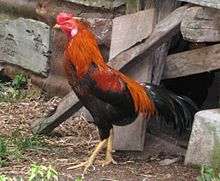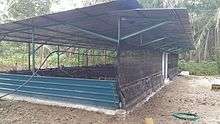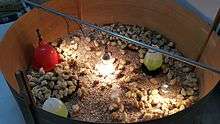Ayam Kampong
The Ayam Kampong (older spelling) or Ayam Kampung is the chicken breed reported from Indonesia and Malaysia.[1] The name means simply "free-range chicken" or literally "village chicken". In Indonesia, the term ayam kampung refer to indigenous chickens that are raised using traditional free range production techniques by almost every household in the village.[2] It is a diverse population which resulted from the uncontrolled cross-breeding of red jungle-fowl, indigenous Southeast Asian chickens and exotic chickens of various types imported in the late 1800s by European, mainly Dutch and British, settlers.[3][4][5]
 Cock of the black-red type | |
| Conservation status | least concern |
|---|---|
| Other names | Ayam Kampung |
| Country of origin | Indonesia and Malaysia |
| Use | dual-purpose |
| Traits | |
| Weight | |
| Egg color | white and brown |
| Classification | |
| |
_female..jpg)
Characteristics
The Ayam Kampong is a small dual-purpose chicken. They are slow-growing breed that contributed to its low productivity. Both its physical characteristics and its colouring are highly variable.[5] Three principal colour types are recognised. The commonest is the black-red variety, in which cocks are mainly green-black with glossy red-brown back, neck hackles and saddle feathers. Other varieties are the red type and the naked-neck type.[1]
Use


Traditionally Ayam Kampong have been raised by most of the rural population of Indonesia and they represent an important source of meat and eggs. However, due to their low production, Ayam Kampong are not able to provide consumption on a daily basis. Nevertheless, they are traditionally consumed on most family occasions and celebrations.[2][6]
Ayam Kampong hens left to forage lay about 55[7]:9 or 100[4] brown eggs per year, with an average weight of 39 g.[7]:9 The poor performance as an egg producer is attributed to the broodiness of the hens.[4]
In meat production, birds reach a market weight of 1–1.5 kg in four or five months.[4] The meat commands a higher price than that of commercial breeds.[7]:71
See also
References
- Breed data sheet: Ayam Kampong/Malaysia. Domestic Animal Diversity Information System of the Food and Agriculture Organization of the United Nations. Accessed August 2014.
- Kusuma Diwyanto and Sofyan Iskandar. "Kampung Chickens: a Key Part of Indonesia's livestock sector". FAO. Central Research Institute for Animal Sciences and Research Institute for Animal Production. Retrieved 26 November 2014.
- I. Aini (1990). Indigenous chicken production in South-east Asia. World's Poultry Science Journal 46 (1): 51–57. doi:10.1079/WPS19900010(subscription required)
- E. A. Engku Azahan (1994). The red and black-red native chickens of Malaysia = Ayam kampung Malaysia jenis merah dan hitam-merah Archived 3 September 2014 at the Wayback Machine. Malaysian Agricultural Research and Development Institute (MARDI) Research journal 22 (1): 73–78.
- Khalid K. Kadhim, Md Zuki Abu Bakar, Noordin Mohamed Mustapha, Mohd Amin Babjee and Mohd Zamri Saad (2014)The Enzyme Activities of Pancreas and Small Intestinal Contents in the Malaysian Village Chicken and Broiler Strains. Pertanika Journal of Tropical Agricultural Science 37 (2): 203–214.
- Buletin Penternakan Ayam Kampung(2010). Department of Veterinary Services of Malaysia, 3rd Volume, 2010.
- Emmanuel Babafunso Sonaiya; S E J Swan (2004). Small-scale Poultry Production: Technical Guide. Rome: Food and Agriculture Organization of the United Nations. ISBN 9789251050828.